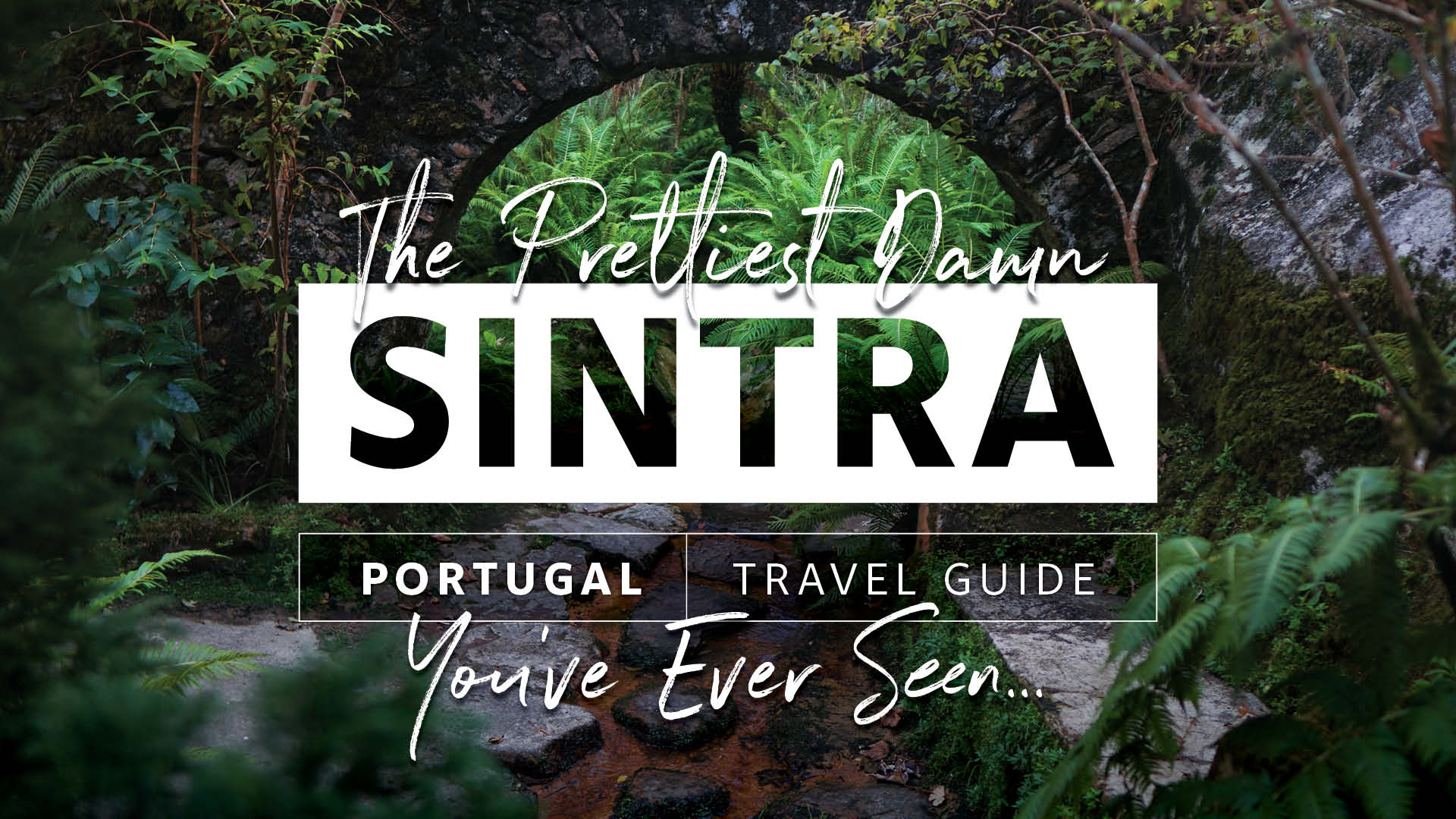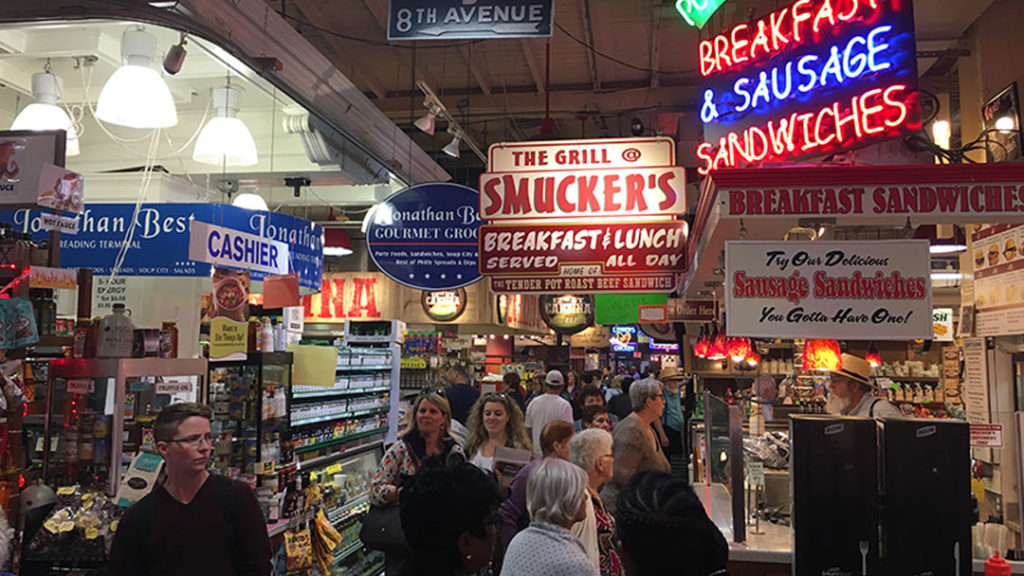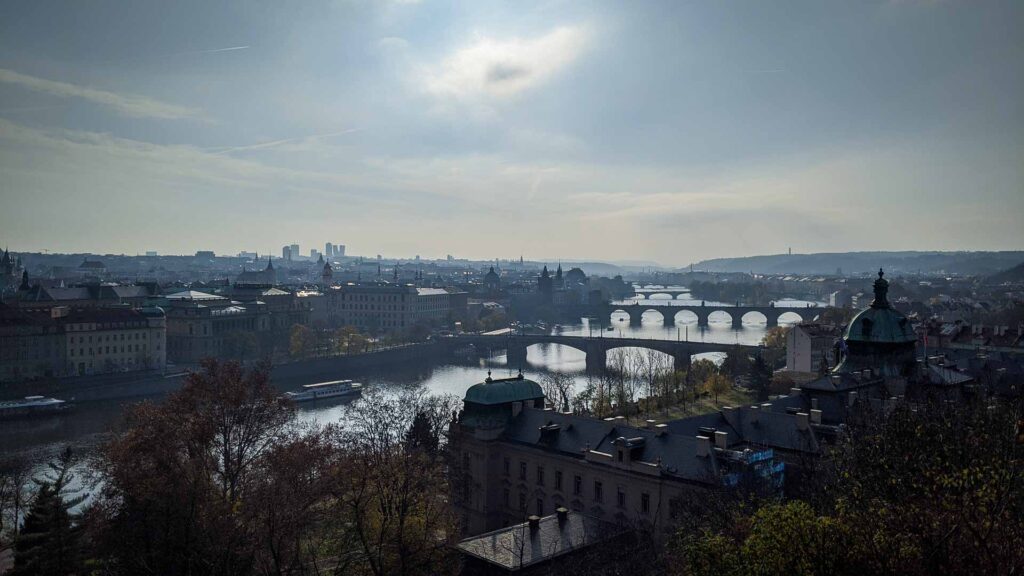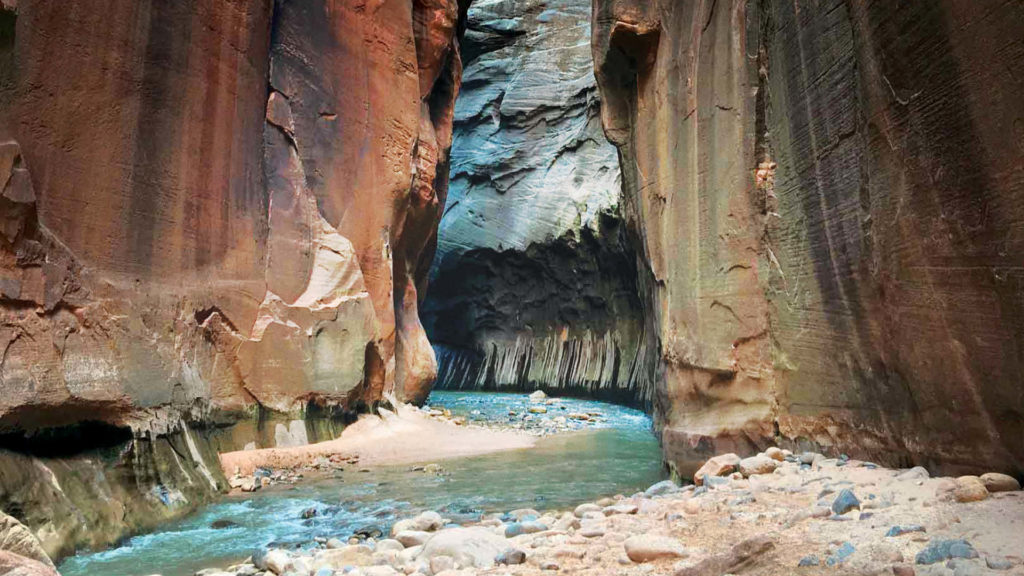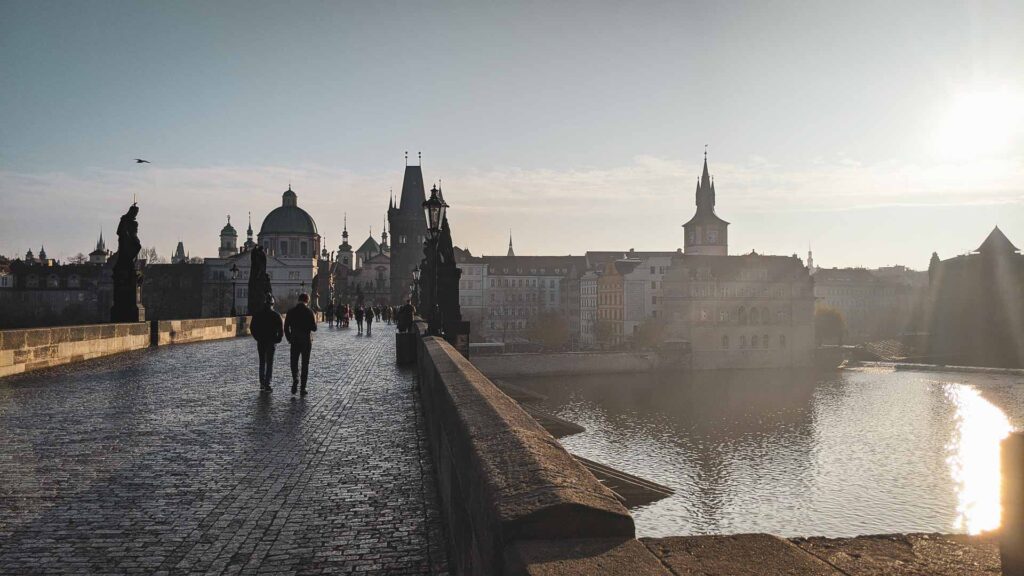The Prettiest F*cking Sintra, Portugal Travel Guide You’ve Ever Seen—AKA: Isn’t It Romanti…cism?
Sintra, Portugal: Yellow Palaces, Twenty-Five Foot Fern Trees, & Fairy Tale Gardens
I spent eight nights in Sintra, Portugal, and I would happily go back for a month. Yep, I said it. I had been looking forward to Sintra since I bought my flight to Portugal. I was more intrigued by Sintra than Porto, Guimaraes, Aveiro, Lisbon, or any of the other amazing places I planned to visit. Why? Well, this Sintra travel guide will get to the bottom of all of that, but I’ll start with one word: Nature.
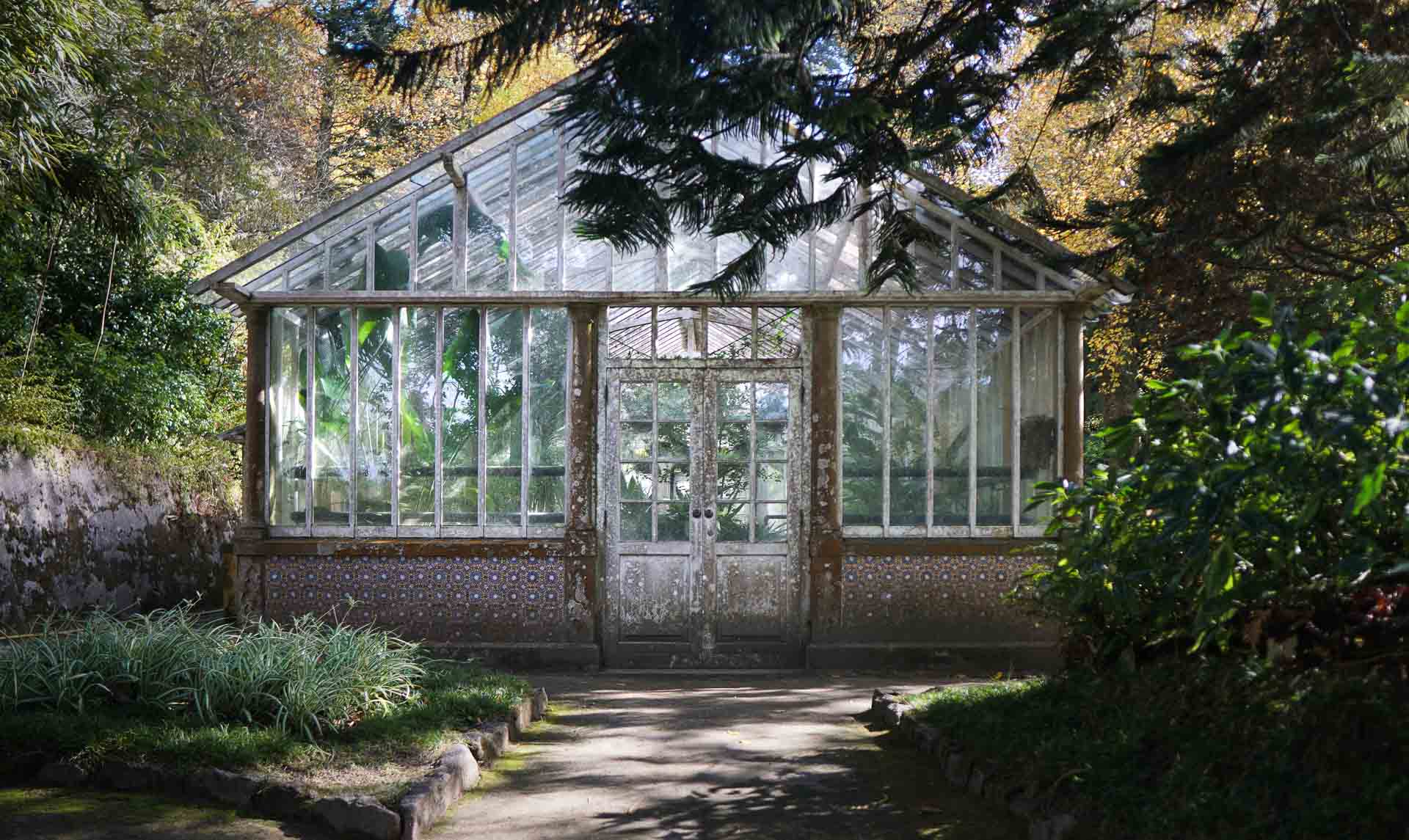
This site participates in the Amazon Services LLC Associates Program and other affiliate programs and may earn from qualifying purchases. You’re never charged more, but it helps out little by little! Check out “Privacy” in the top menu if you need to know more!
When compared on a map to all of those other cities in Portugal, you’ll notice an immensely larger amount of green surrounding Sintra. The small city is literally on the edge of Sintra-Cascais Natural Park, one of over a dozen protected natural parks throughout Portugal. And if you’ve been paying attention, you know I love me some nature.
Combine that nature element with the other-worldly Romanticism-inspired palaces, complete with some of the most elaborate and extensive gardens I’ve ever seen, and I was in heaven.
Bright yellow and red palace? Check. Nearly 100ft deep “initiation well?” Got it.
Twenty-Five foot fern tree gardens complete with fairy tale-like footbridges?
Yep, Sintra, Portugal has ’em all.
And don’t take my word for it. I’ve spoken to dozens in the recent weeks since I’ve been, and they were all blown away and wished they had stayed for longer in Sintra.
This Sintra travel guide also happens to have some of my absolute favorite photos that I took while in Portugal. (You just saw it above, the old greenhouse.) Hope you dig em. If so, make sure you’re following along on Instagram, as I shared a lot more over there!
Connect & Share This Article
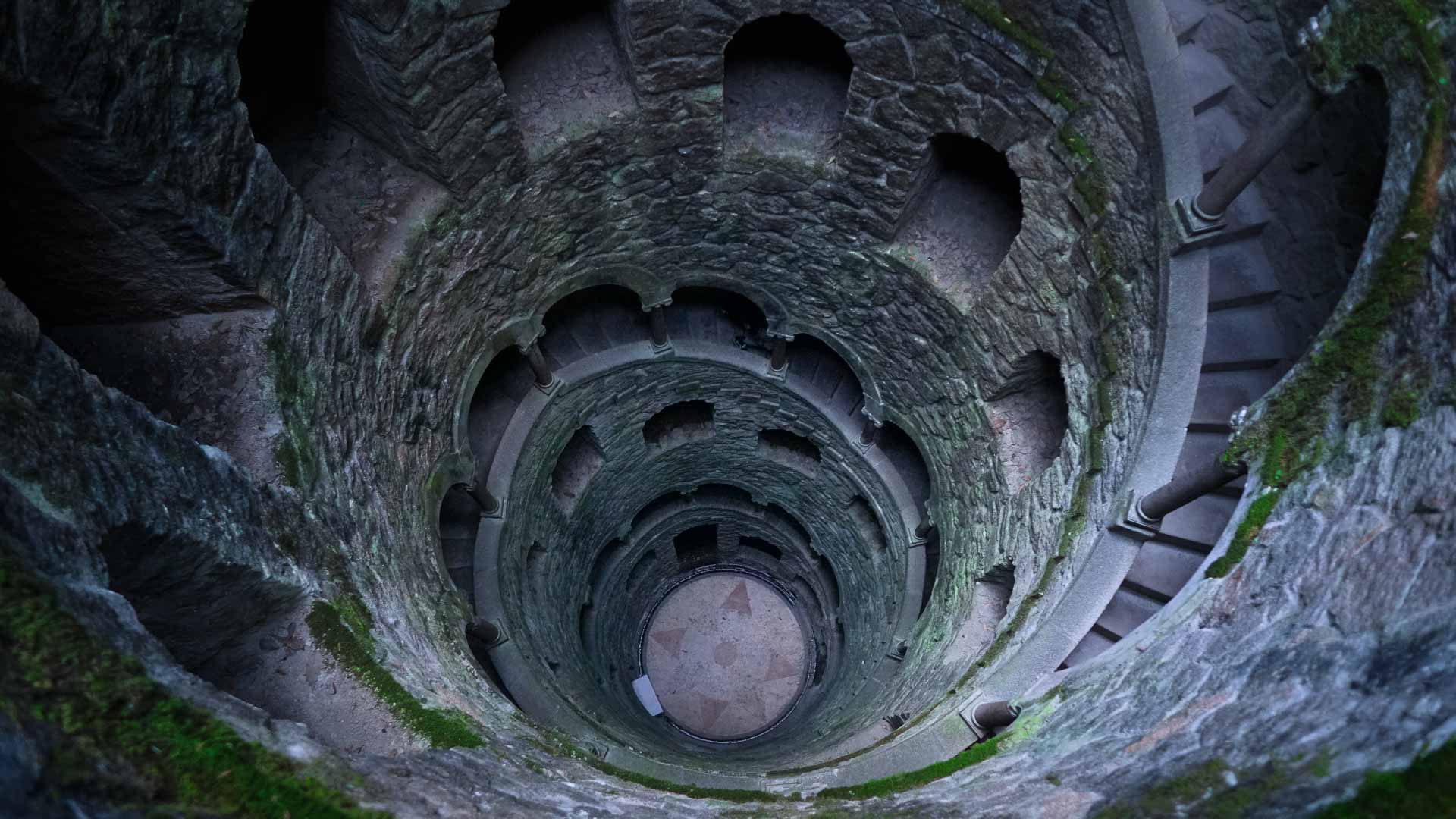
By the way. The photography on this website is originally shot and edited by me…Jason. (Pleased to meet you if it’s your first time here.) If you want to see and read more, I would love it if you followed along on Instagram. There you’ll find much more photography, travel advice, and occasionally even some words of wisdom about this magical winding road of life.
Explore Portugal Travel Guides
Porto Travel Guide | Sintra Travel Guide | Guimaraes Travel Guide | Aveiro Travel Guide
READ NEXT: What The Heck Is The Schengen Zone? How U.S. Passport Holders Travel Europe For Months On End
Part 4: Year 1 As a digital nomad – Life Lessons Learned While Solo Backpacking Europe…
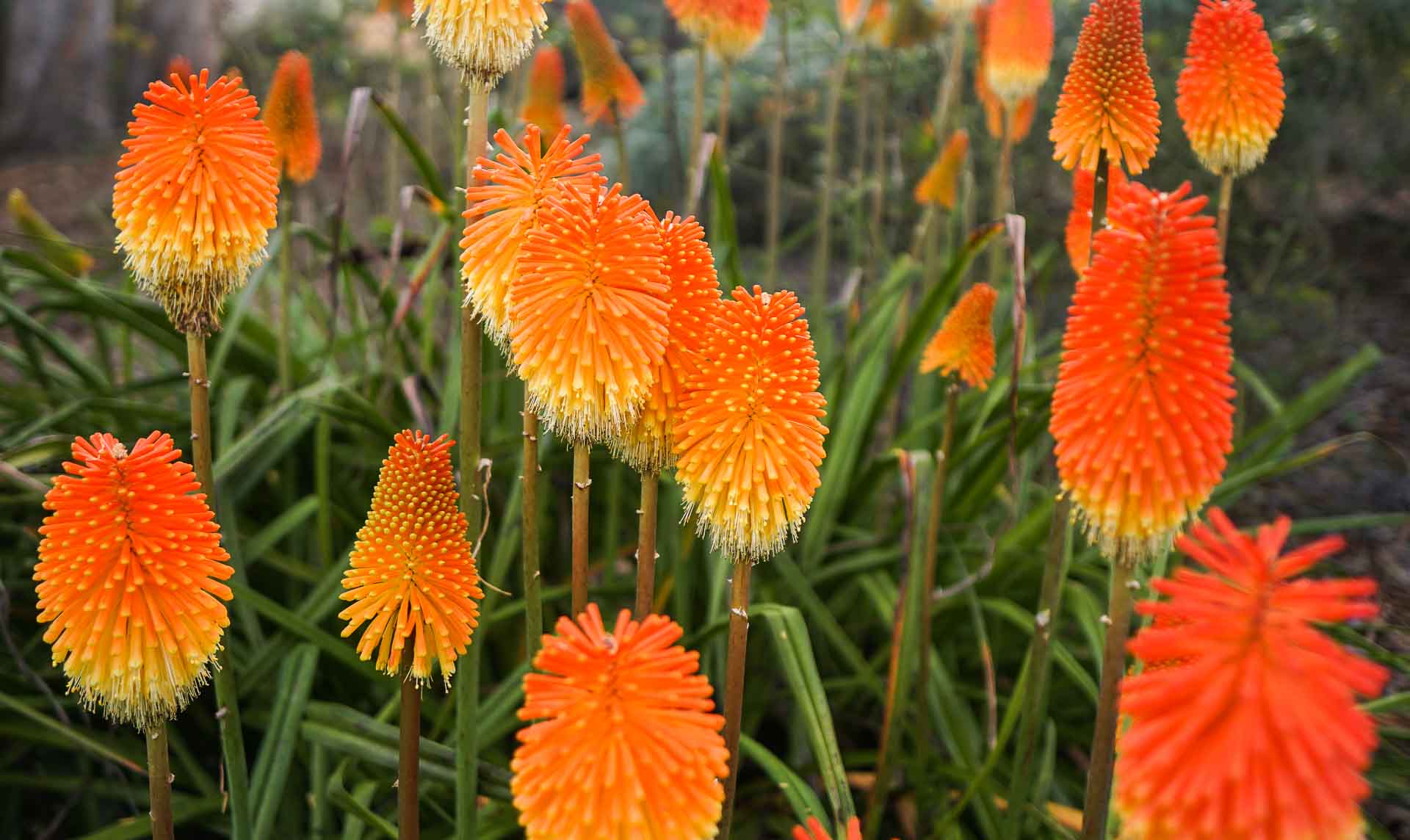
The Best Things To Do In Sintra, Portugal – My Top 3 Recommendations
To be honest, I was in Sintra for a recharge, so I didn’t go nuts. I worked a good bit and napped a lot while staying at an amazing and inexpensive B&B with a real wood fireplace to warm up next to. But when I did go exploring I hit it hard. Again I could easily go back for a month and really take advantage of all of the nature in Sintra.
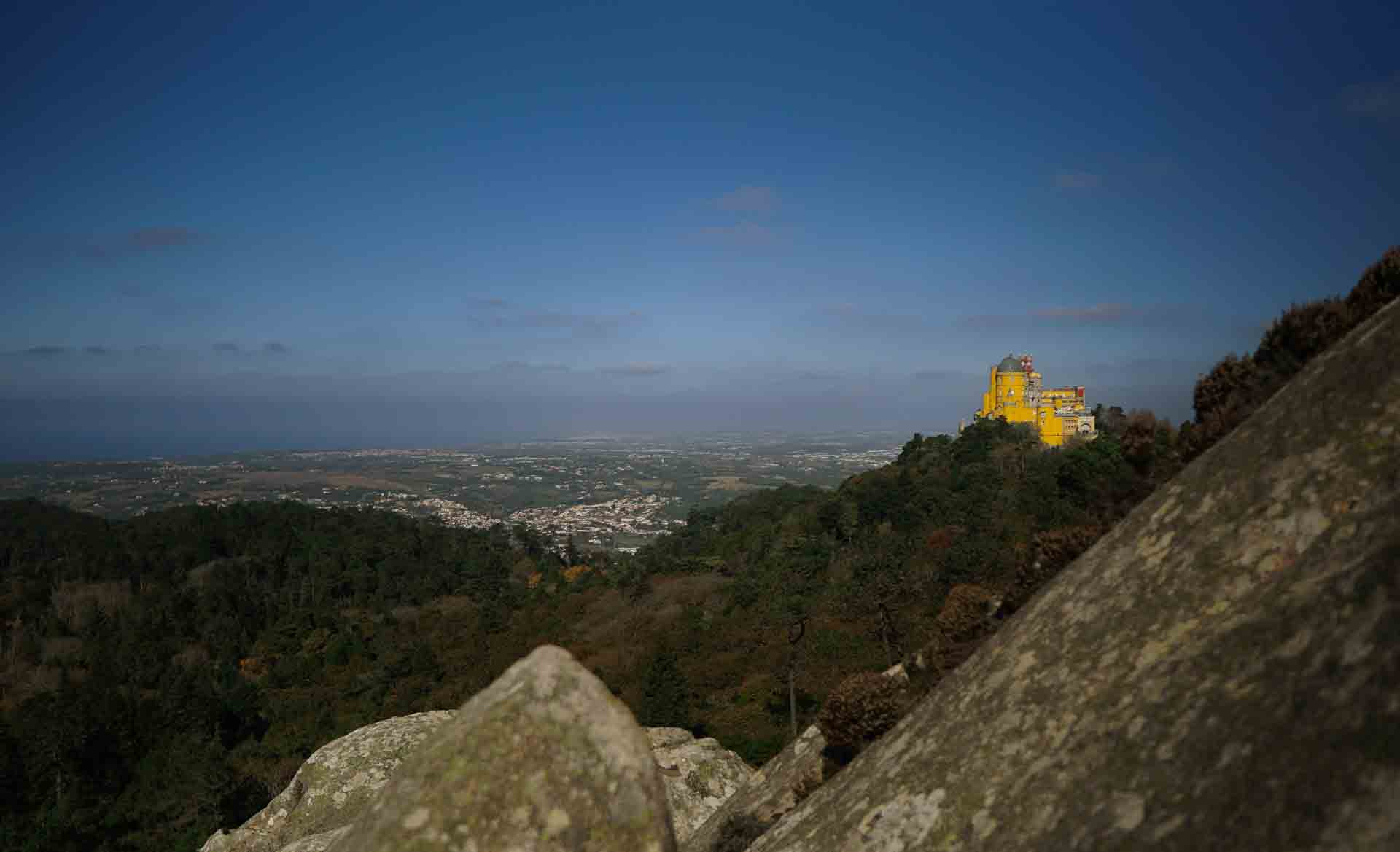
Spend An Afternoon Visiting The National Palace Of Pena And The Endless Gardens And Trails
Even if you’ve never been to Portugal, you’ve probably seen pictures of the Pena Palace. Its yellow, red, and blue whimsical exterior is unmistakable. “The King-Artist” Ferdinand II really took everything to the next level with regards not only to the palace itself, but in the palace grounds. The entire experience at Pena Palace is really like something out of a fairy tale.
First off, I didn’t plan on going inside of the actual palace. I’m usually more interested in plants than interiors, honestly. The cost for a ticket to the grounds and the terraces of the palace is around €10. To go inside, it was an extra few euros, and I definitely almost passed on that. But in the end, I said to myself…“Self, you’re here, pay the extra couple bucks and be a tourist!” And Oh am I glad I did. The exterior is cool, but the interior is even more over the top.
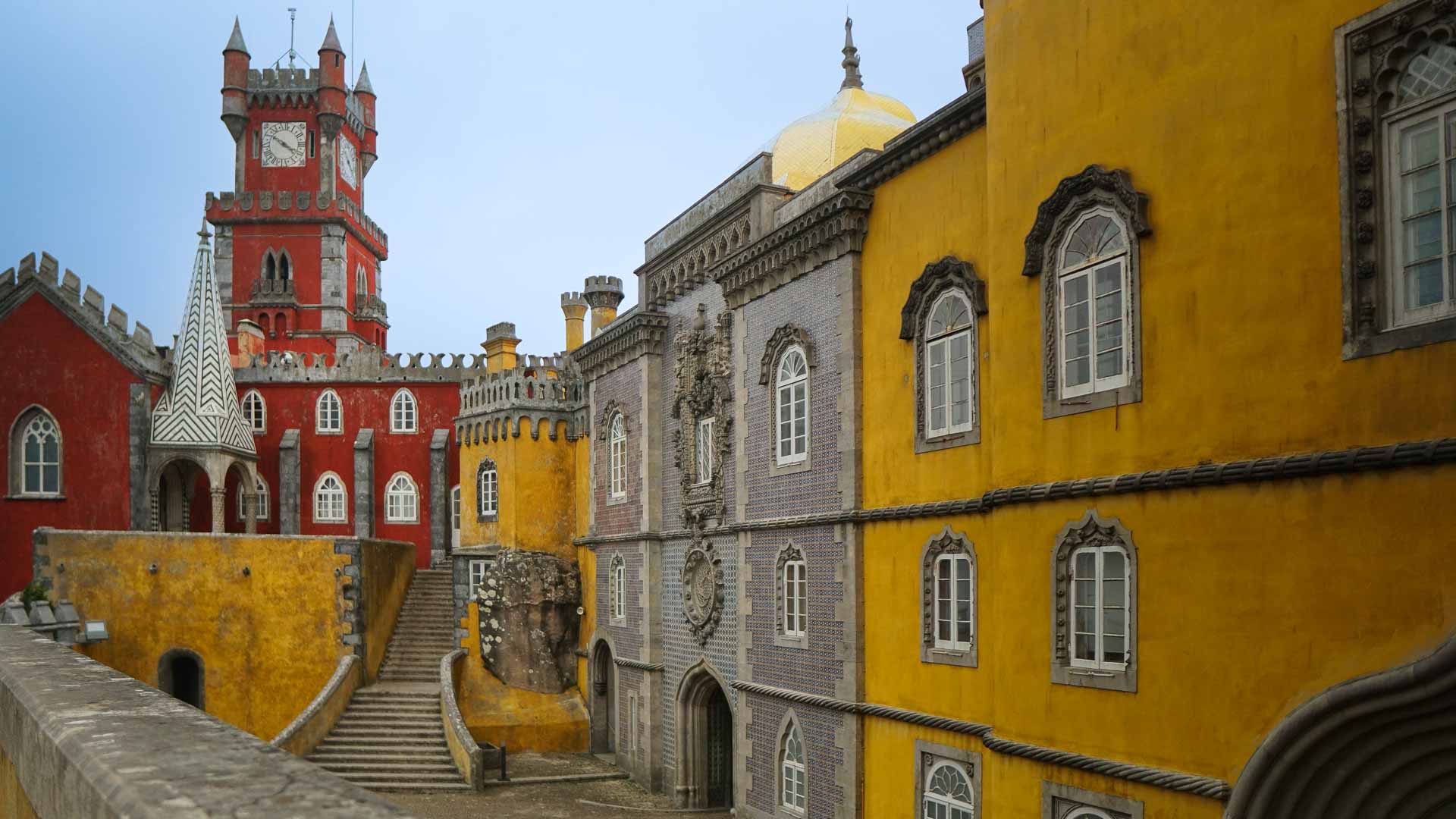
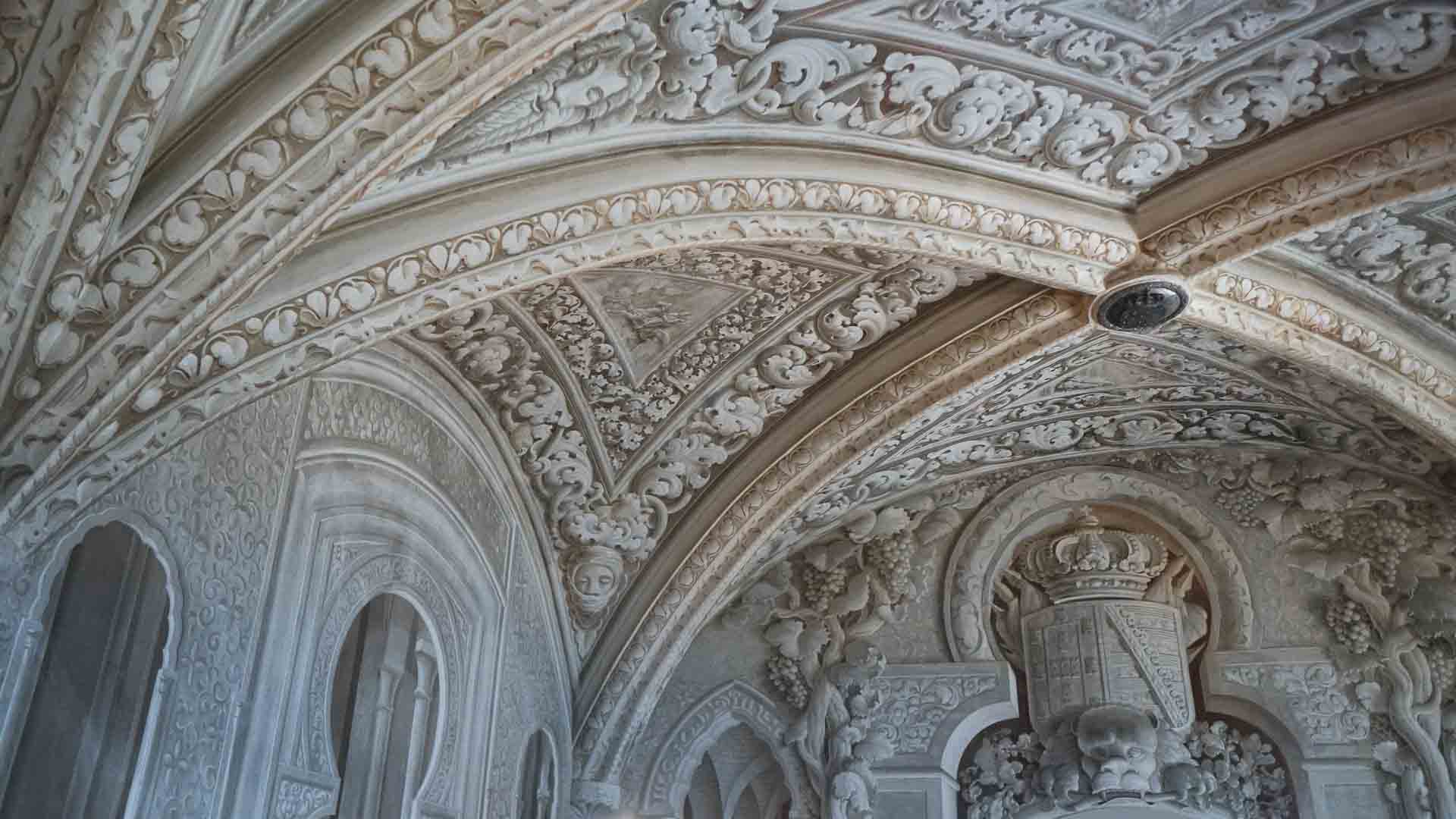
Inside Pena Palace, it’s decorated in many different period styles, including Neo-Islamic, Neo-Gothic, Neo-Manueline, and Neo-Renaissance. That might not mean much to you, but essentially, it’s a visual feast of eclecticism. The most impressive in my opinion being the rooms that are painted to look entirely dimensional…but it’s all just paint. Doorways painted on walls, leading to hallways and more doorways…that are actually just painted flat walls.
Articulate ceilings that look so ornate and dimensional that you want to reach out and touch the details…but it’s all just paint.
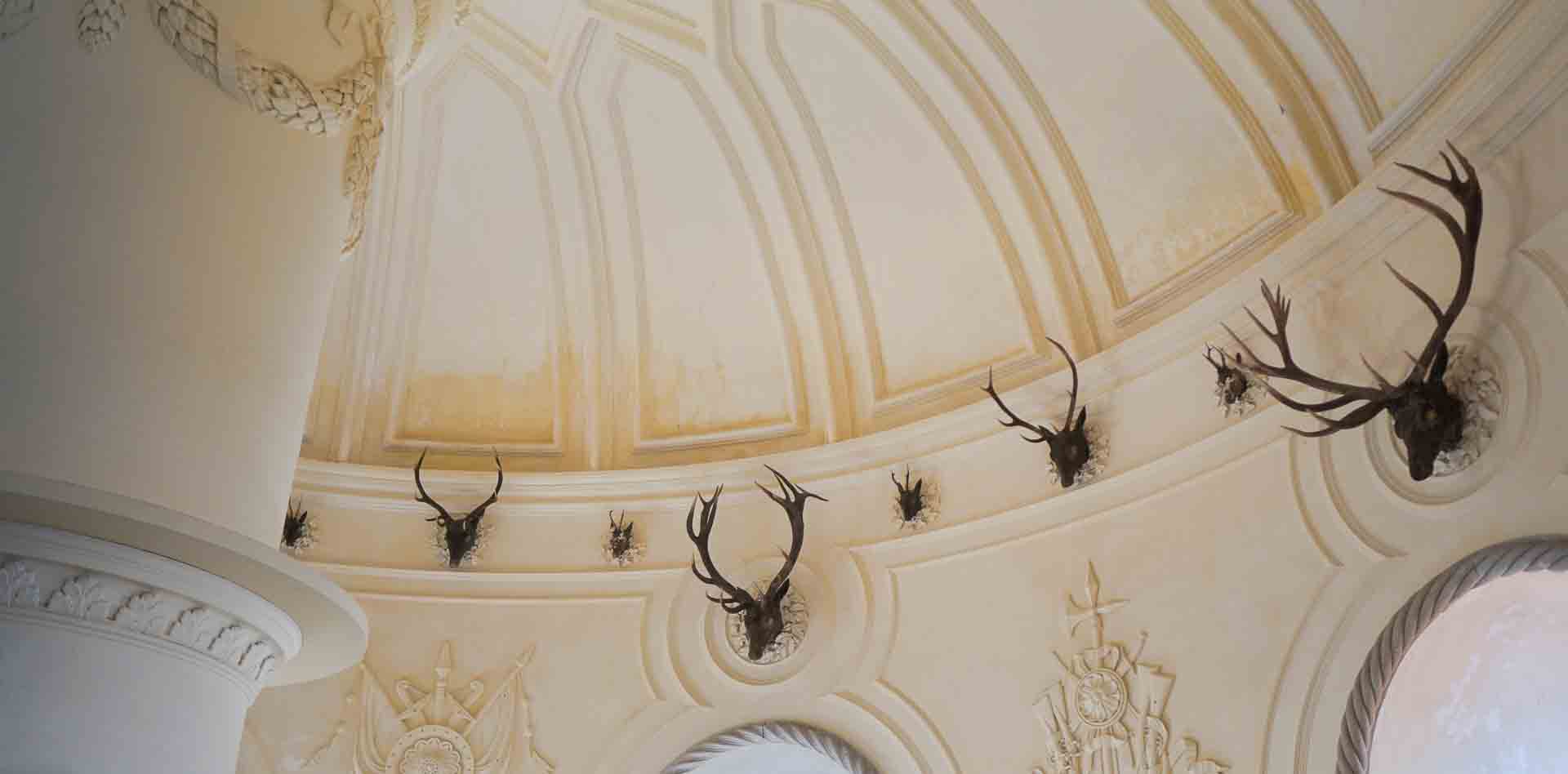
READ NEXT: Jaw-Dropping Images Of Pena Palace & Gardens in Sintra, Portugal
A Visual Feast Of Romanticism – Monserrate Palace in Sintra, Portugal
Then There Are The “Gardens” Of Pena Palace
Just calling them “gardens” is probably the most understated and diminutive way to describe the grounds at Pena Palace. It’s actually an elaborate network of trails, many unmarked, that you can literally spend a day in without doubling back on the same spot twice.
I know, because I spent nearly six hours happily getting lost in the gardens of Pena Palace and never saw the same thing twice.
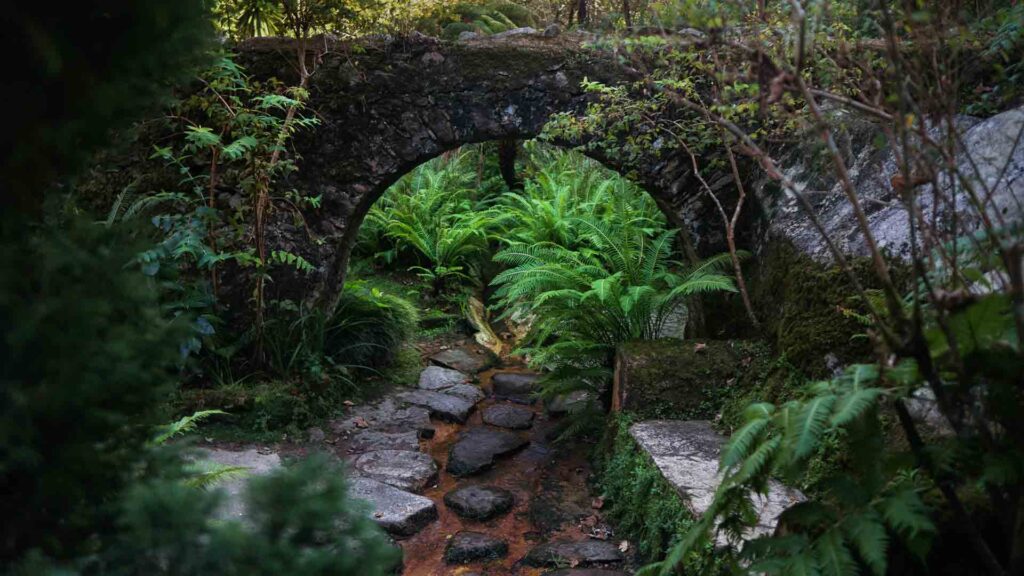
It’s truly magical. Complete with fern species imported by Ferdinand and his family from around the world. The microclimates of Portugal were perfect for this, and the rich family truly took advantage of their opportunity to embellish. Different areas of the gardens at Pena Palace are completely devoted to different types of plants grown in different climates or parts of the world.
And the best part is that most people barely seem to venture more than a few hundred meters off the Pena Palace terraces or the main paths from the entrance to the Palace. I highly suggest that you plan a half a day and simply get lost. Most people I’ve met during my travel in Portugal agree that they wish they had allowed much more time for Pena, so it’s not just my opinion!
READ NEXT: Jaw-Dropping Images Of Pena Palace & Gardens in Sintra, Portugal
Explore The Palace Of Monserrate And Its Amazing Gardens
You’re probably seeing a trend. I mean, I did tell you that Sintra, Portugal is all about nature. The Palace of Monserrate is another amazing example of eclecticism and Romanticism both inside and out. Truly a gift of extravagance from Francis Cook in the 1800s. But compared to Palace Pena and its gardens, Monserrate is quite a bit smaller. So if spending hours traversing isn’t your jam, it’s the perfect place for a less exhaustive trek.
The other nice thing about The Palace of Monserrate is that it’s about 4km from Sintra proper. It’s far enough away and off the radar that the crowds seem to be much smaller than Palace Pena or Quinta Da Regaleira Palace.
READ NEXT: A Visual Feast Of Romanticism – Monserrate Palace in Sintra, Portugal
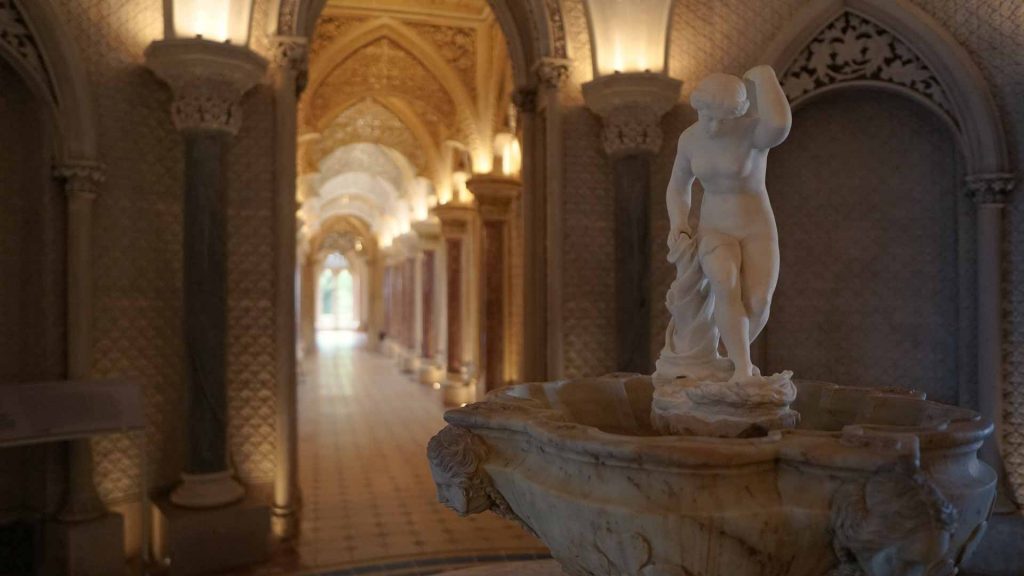
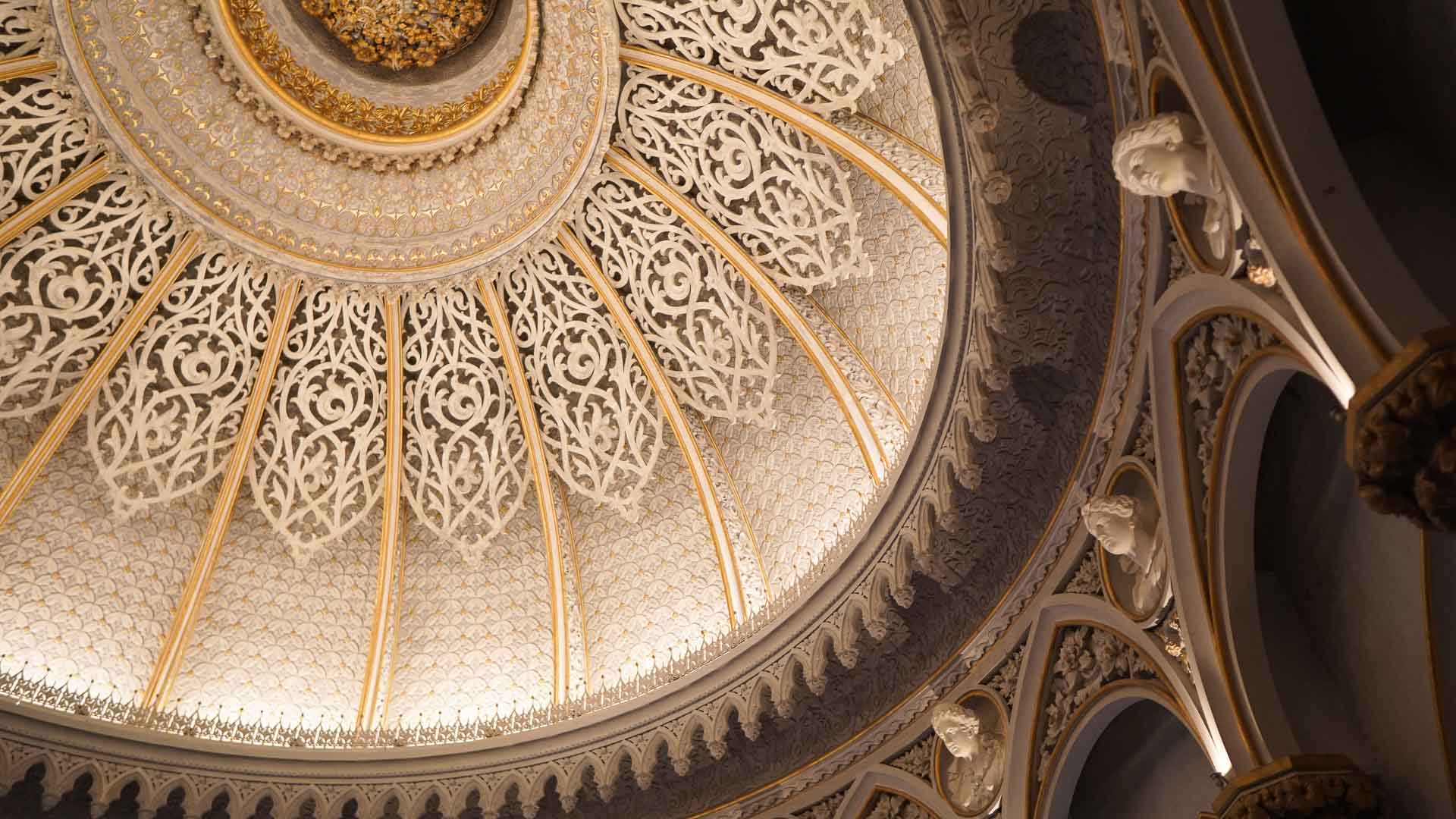
Join the email list to stay in the loop on new releases!
While fairly small, the interiors are truly majestic, with two long corridors of repetitive columns and statues extending from a central room. That room is over two stories tall with a gorgeous ceiling. At the ends of the two halls are other elaborately decorated, filigreed spaces. Seriously, I’m kind of running out of synonyms for the words “amazing” and “gorgeous.”
Move outside to the gardens and a similar theme to the gardens at Pena Palace becomes evident. Species from around the world were imported to replicate the plants found there. You can literally explore the “Mexican Gardens” and see massive agave plants that are more than 10’ wide. Or get lost in expansive fern gardens with species from Australia and New Zealand. Some of these ferns were even taller than the ones in Pena.
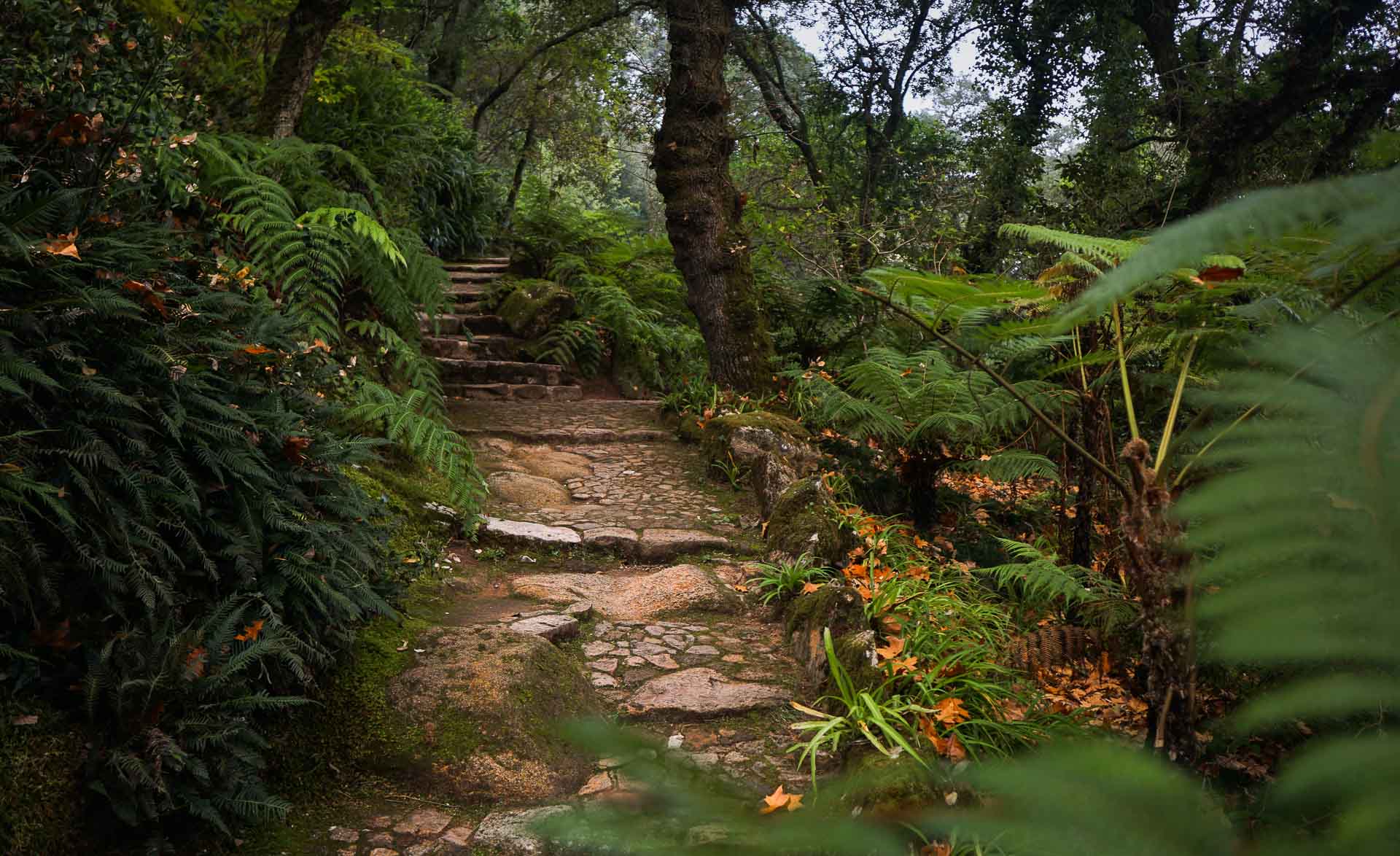
Plan to spend at least 2-4 hours at The Palace Of Monserrate and just take your time. You can get a ride share or a tuk-tuk from Sintra for around €5 one-way. Adult tickets that get you the grounds and palace are under €10.
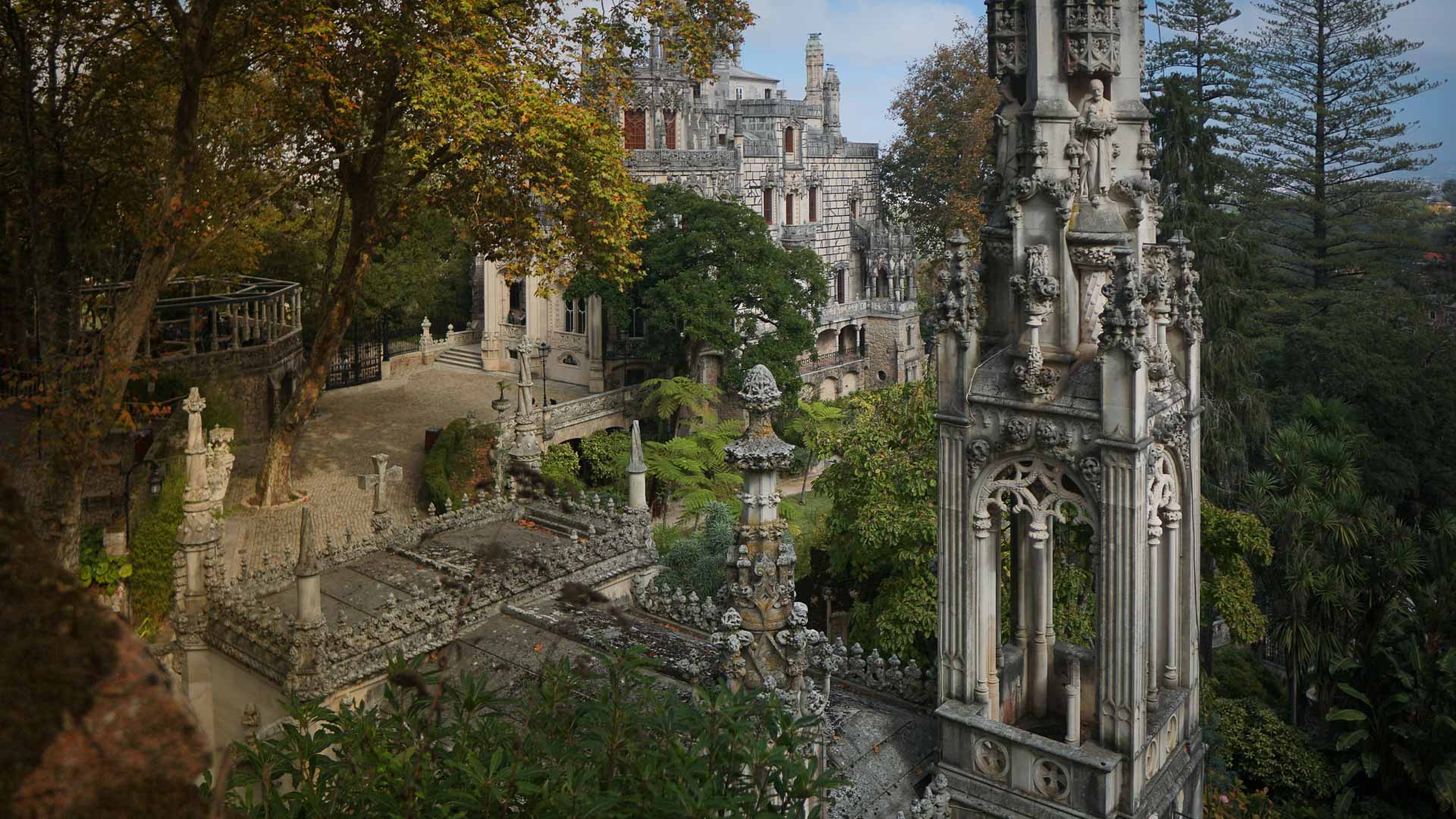
Visit Quinta Da Regaleira Palace, Gardens, And The “Poço Iniciático”….The Initiation Well
Another obligatory entry in any proper Sintra travel guide is a visit to Quinta Da Regaleira Palace and “The Initiation Well.” This is one of the easiest major sites to get to in Sintra, as it’s just a short walk from old town.
The thing about the Initiation Well is that it’s actually quite…tight? To put these pictures into perspective, it’s about 80’ deep…so it’s really only about 15-20’ across.
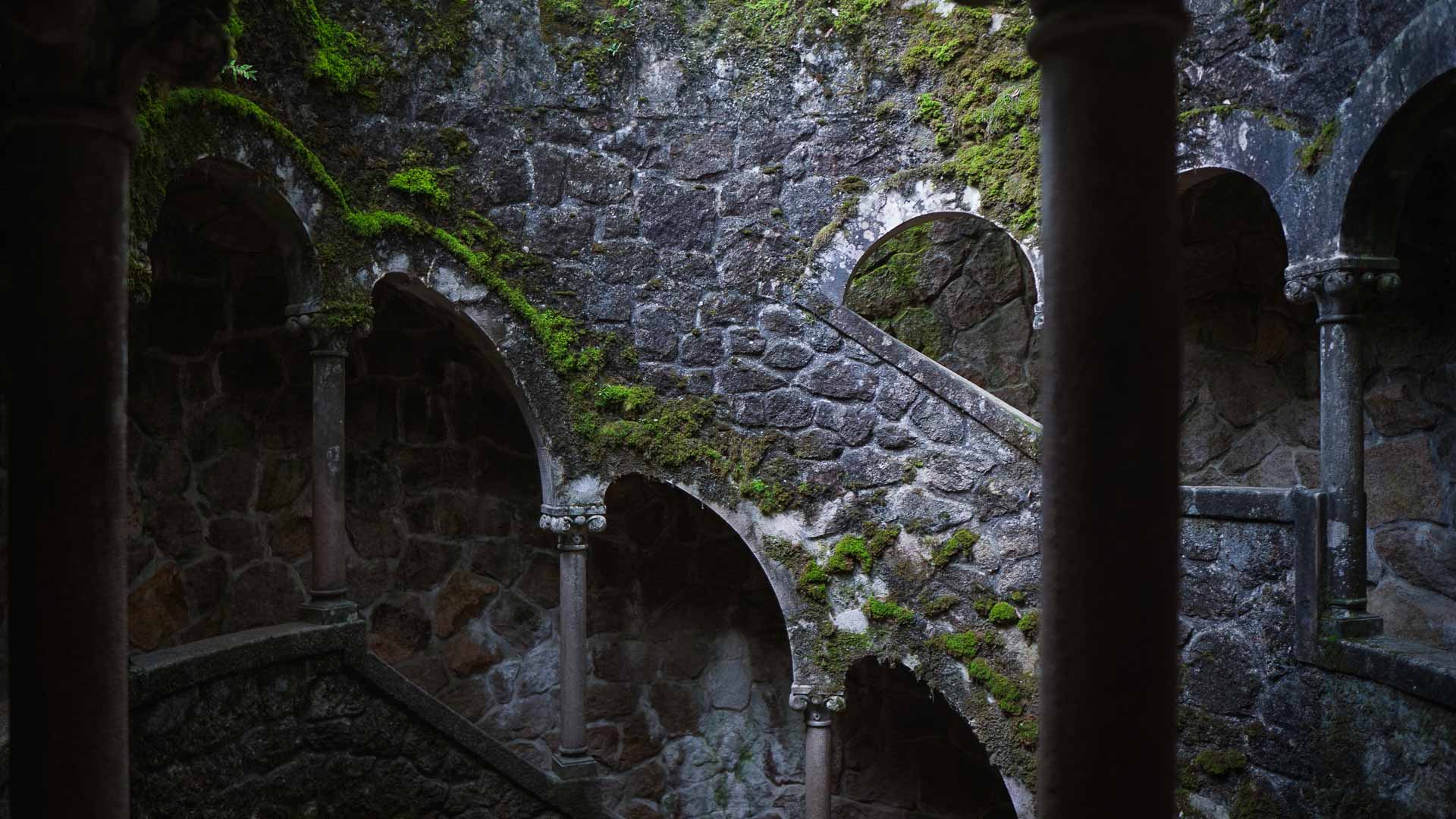
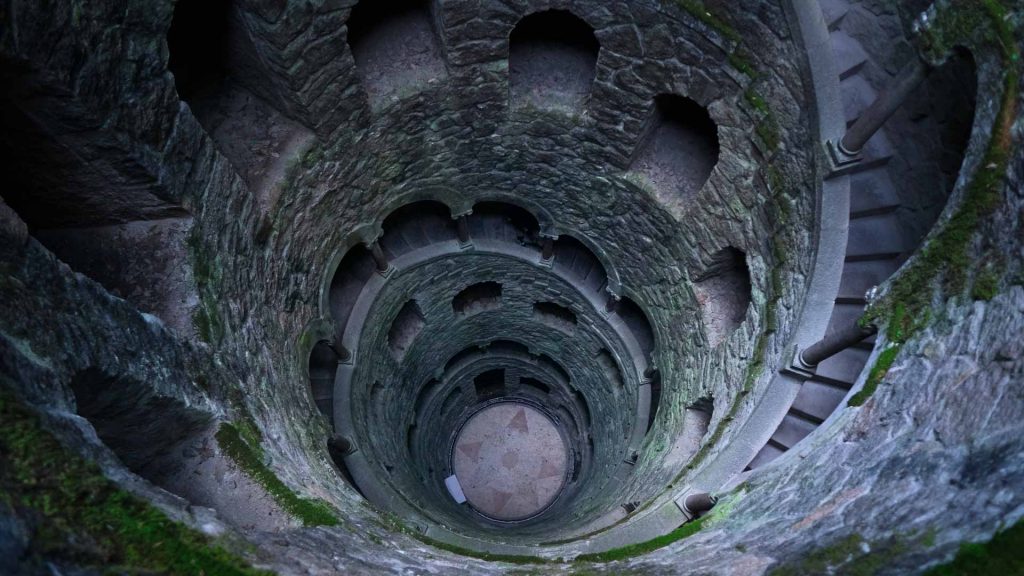
Get to Quinta Da Regaleira early and head straight up to the initiation well. It’s one-way traffic, from the top to the bottom, and as crowds grow they encourage people to keep it moving. So if you want some baller photos without people in them, you really have to aim for optimal conditions!
The grounds and gardens of Quinta Da Regaleira are more places where you could easily spend an hour or two just wandering. Tons of main paths with grottos and water features, but also plenty of side paths to explore. Leave a little time for the actual palace, but don’t expect the extravagant scenes you’ll see at Monserrate or Pena. No comparison. Adult tickets are around €10, and you should plan to spend at least 2-3 hours exploring.
READ NEXT: Jaw-Dropping Images Of Pena Palace & Gardens in Sintra, Portugal
A Visual Feast Of Romanticism – Monserrate Palace in Sintra, Portugal
More Things To Do In Sintra, Portugal
Visit The Sintra National Palace (Palácio Nacional De Sintra)
The Sintra National Palace is literally the oldest palace in all of Portugal. Also, nearly every king and queen of Portugal used it as their residence. While nowhere near as extensive as, and without the elaborate gardens of Pena Palace or Monserrate, it’s definitely worth the visit, especially since it’s close to old town. The cost for entry to the Sintra National Palace is around €13.
Walk The Gardens Of Vila Sassetti Up To The Ruins Of Castelo Dos Mouros
The ruins of the Moorish Castle, perched on top of the highest visible peak, will likely be the first thing you see when you arrive in Sintra. You’ll probably look up and be all “whoa, what’s that!? I wanna go there!” And rightfully so. The ruins are truly unique and can transport you back in time almost 1000 years as you walk slowly around the many fortified walls and silos. You’ll be treated to amazing views of Pena Palace, the countryside, and the Atlantic ocean off to the west.
The first day I walked to the Moorish Castle ruins in Sintra, I took mostly roads and trails, listening religiously to my mapping app. The next time I was simply wandering around and stumbled upon Vila Sassetti, which is the route you should definitely take!
Vila Sassetti is open during the same times the Moorish Castle and Palace Pena are…and it’s free! It’s a gorgeous, manicured garden full of hidden paths and intricacies. I was there in fall, so I can only imagine how beautiful these paths are when in full bloom. You start walking up just outside of old town. Once you spend the 20-30 minutes winding up the Vila Sassetti trails you’ll exit the other side to natural trails that will lead you up to the Moorish Castle ruins or Pena Palace. Just follow the signs.
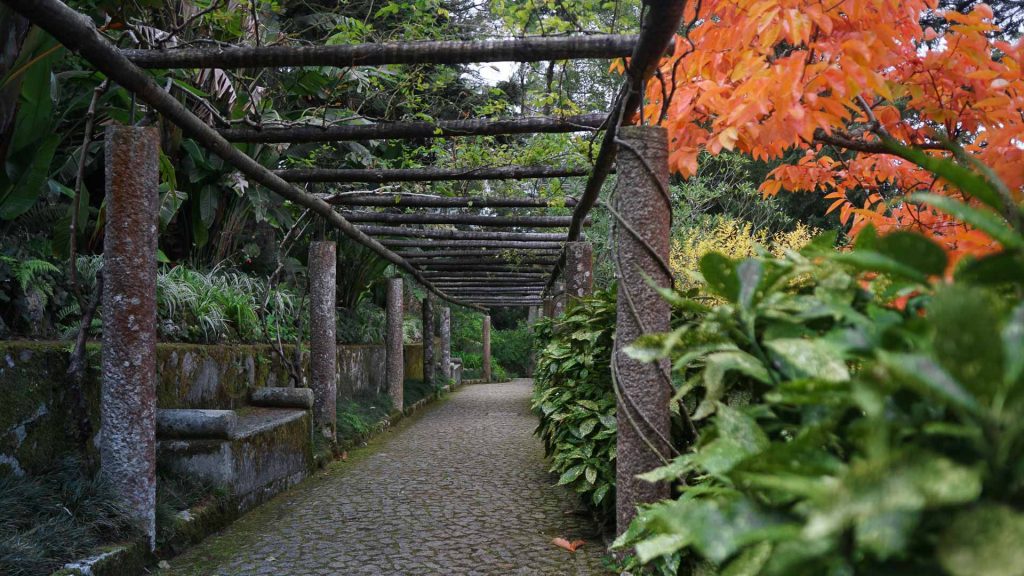
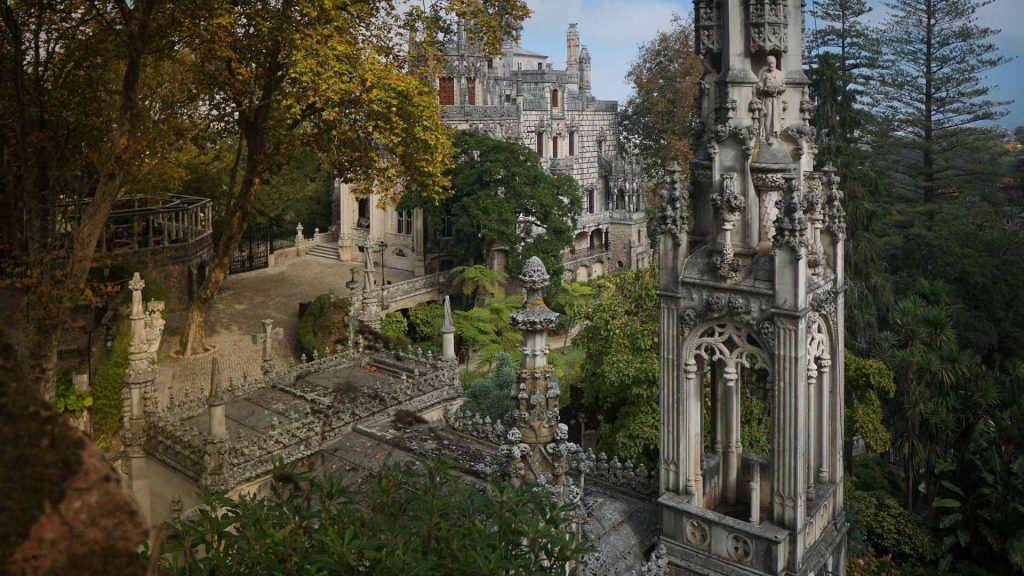
Tickets into the Moorish Castle ruins should be under €10, and you’ll probably want to spend about an hour or so there. Bring a jacket, it gets windy up there.
Drink Local Craft Beer On Tap At Villa Craft Beer & Bread
This is a little off the norm, but to find a tiny craft brewery with some delicious eats in a place like Sintra isn’t an everyday occurrence. I was pleasantly surprised by the quality of the beer, and sitting outside next to a quaint side road somehow made the moment more memorable. While the craft beers throughout Portugal tend to be just about as expensive as one back in the States, every once in a while I just need a good beer!
READ NEXT: Jaw-Dropping Images Of Pena Palace & Gardens in Sintra, Portugal
A Visual Feast Of Romanticism – Monserrate Palace in Sintra, Portugal
Hike In Sintra-Cascais Natural Park, Where The Land Ends And The Sea Begins
There are literally dozens of established, marked trails in Sintra-Cascais Natural Park. They were one of the reasons I really wanted to travel to Sintra in the first place, but I’ll have to go back to experience all of them. (Then I’ll make a Sintra travel guide for all the hardcore hikers out there.)
Because you’re so close to the ocean, you can include a detour to enjoy the coast pretty easily. There is also plenty of mountain biking, and when you’re visiting Sintra you’ll often see folks riding from the city up towards the park. Heck, I saw plenty of MTB riders in Lisbon literally getting on the train with their mountain bikes, likely taking the quick 45m train ride to Sintra!
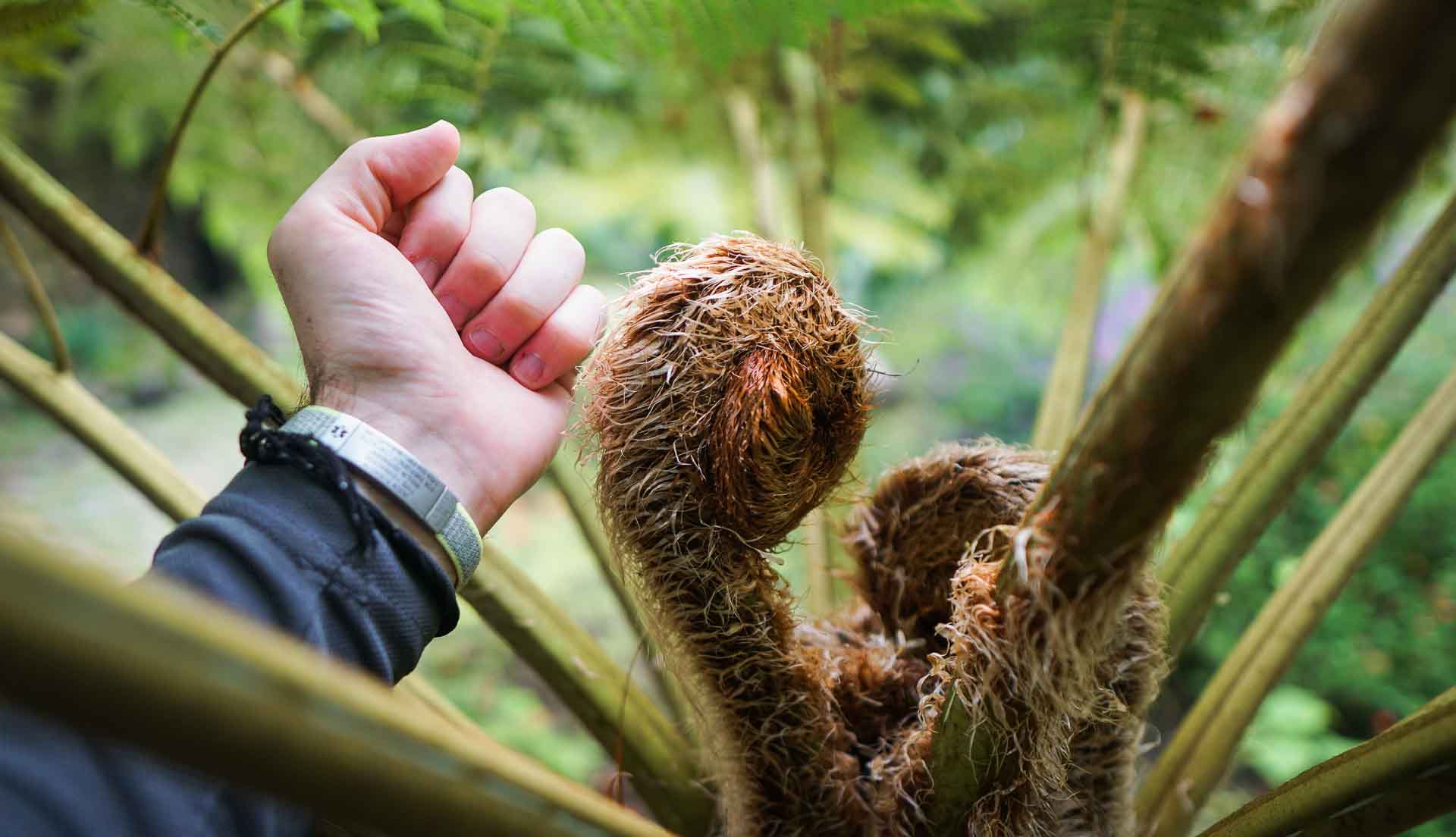
Explore Park Liberdade (Parque da Liberdade) Botanical Gardens
Especially if you visit Sintra, Portugal in the warmer months, make sure you check out the Park Liberdade Botanical Gardens (Freedom Park). Because these gardens are literally in the center of Sintra, not far from the tourist center, it’s a simple visit. And they’re not extremely massive like the gardens at Palace Pena or Monserrate. So if you or anyone you’re traveling with have mobility concerns or just can’t trek longer distances, it’s a great way to get your nature fix in.
Head To The Atlantic Ocean To The West, Or Go Surfing To The South
Again, Sintra is just over the mountain from the Atlantic Ocean, and there are plenty of easy ways to get there and spend a day. Many hikers I met actually made a day of hiking to the coast and back, but there are also many tours that can get you there. If you want to surf, you can look for a quick train or bus down to Cascais, which is one of the more epic surf towns in Portugal. I spent a few days in Cascais and it was really nice to just smell the ocean air and catch sunsets over the ocean every night.
Explore Portugal Travel Guides
Porto Travel Guide | Sintra Travel Guide | Guimaraes Travel Guide | Aveiro Travel Guide
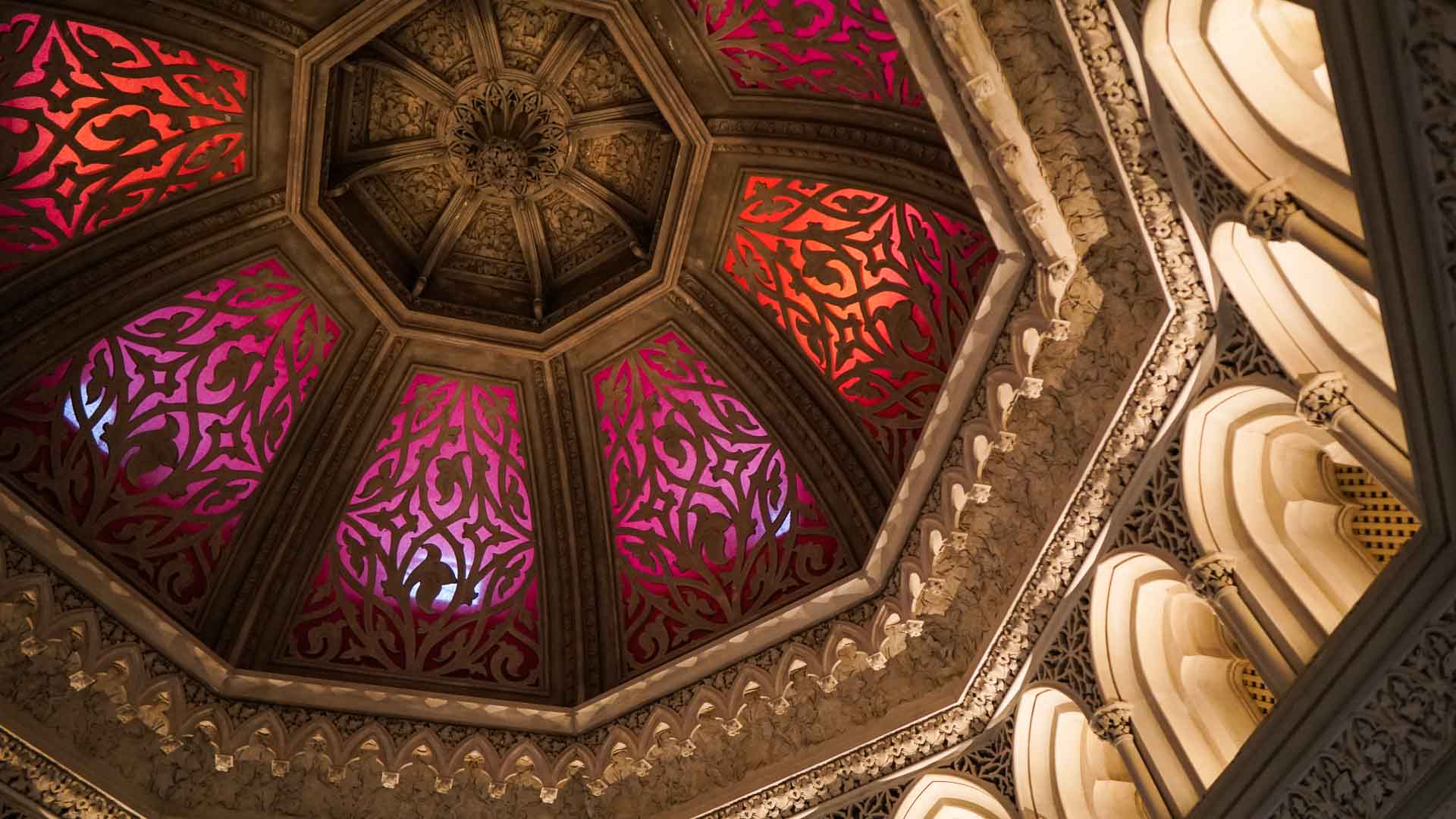
Shop At The Weekend Markets
Because the climate in most of Portugal is pretty comfortable all year long, there are almost always weekend markets. Sintra is no different. There are local artisans that line the streets near Park Liberdade on the weekends, so make sure to take a morning walk and see what they’re offering up.
Visit The Convent of the Capuchos (Convento dos Capuchos)
One of the stops that contrasts the whimsical extravagance of Pena Palace or Monserrate Palace is the Convent of the Capuchos. This modest monastery right in the middle of Sintra-Cascais Natural Park is one that doesn’t make it on the typical tourist route because it’s a little out of the way. This old Franciscan monastery was inhabited by 8 monks back in the 1500s.
Everything is scaled down here, with tiny doorways and living quarters, so it really is an interesting contrast compared to the other larger-than-life palaces around Sintra.
Getting To And Travel Around Sintra, Portugal
Sintra is an easy hourlong train or bus from nearby Lisbon, or a simple but longer trip from any of the northern spots like Porto. Lisbon is the best place to fly into if you’re headed to Sintra, and train tickets are only a couple euros and the trains leave pretty much hourly. The Comboios de Portugal train system is really easy to use, but the bus options throughout Portugal are also pretty on point. Neither should run you more than a handful of euros if you’re coming from Lisbon.
READ NEXT: What The Heck Is The Schengen Zone? How U.S. Passport Holders Travel Europe For Months On End
Delicious Oaxaca City, MEX: The Best Restaurants, Food & Tacos…for $1-20USD
Typical Spending Costs, Travel Styles and Budgets for Travel In Sintra And Throughout Portugal
I’m a budget travel nerd and tend to target traveling internationally for an average of about $30-60 a day, all in. Of course, you can travel cheaper than that, or the sky’s the limit. I was able to average about $50-60 a day in Portugal, and smaller places like Sintra tend to be a little cheaper than the bigger cities of Porto or Lisbon. Especially in accommodations, since I got an amazing hostel bed in a B&B/Hostel with prepared breakfast and an amazing fireplace for less than €20/night.
Beds in a 4-6 bed hostel dorm run typically run about €15-25. Fantastic sit-down meals at most non-bougie restaurants run €7-15+. And I had some pretty fancy meals for less than €20. And a glass of good port, table wine, or draft beer at those restaurants usually starts at about €2. Credit cards are widely accepted, but carry some cash for the smaller joints. ATMs are readily available, but make sure they’re attached to a reputable bank and not a Euronet ATM.
| Glass of cheap wine or beer while out in Sintra | €2-3 |
| Hostel bed in 3-6 person dorm | €15-25+/night |
| Tuk-Tuk or rideshare around Sintra | €3-5 |
| Simple sit-down dinner with wine/beer | €7-16 |
| Church or Museum entries fees | €3-5 (or free) |
Hostels In Sintra
There are only a couple of hostels in Sintra, but there are plenty of other offerings. As I mentioned, I absolutely loved the place I stayed, and they also had private rooms, if that’s your jam. The “dorm rooms” were only three beds, and the fireplace and beautiful breakfast spread the owners prepared every day really helped me to relax. I was in the middle of three months moving around Portugal during covid, so I really needed the recharge! Hostel beds should run you between €15-25+.
There are hundreds of hostels throughout Portugal. You can filter by rating, location, amenities, cost, etc., here.
Staying Safe While Traveling In Sintra…Or Portugal In General
Honestly, there wasn’t a moment when I was wandering around Sintra when I felt unsafe. That said, you should always take some necessary precautions when you’re traveling. Explore with a friend or two if possible, and consider staying out of the dark corridors at night if you’re solo. Yes, they’re kind of magical at night, but just be cautious.
Essentially, use common sense and go with your gut if you feel unsafe or concerned. I also suggest wearing clothing that allows you to zip or button up your wallet, phone, etc., as most of the time the biggest concern in bigger, tourist-heavy cities is pickpockets in dense areas. If someone else is an easier target than you, then your odds of trouble are reduced! (You don’t have to run faster than the bear…)
Travel To Sintra And Throughout Portugal: Travel Basics & Important Logistics
Here are the nitty-gritty details you need to know before you plan your trip and travel to Sintra or just Portugal in general.
Where Is Sintra, Portugal? The country of Portugal is located on the western coast of Europe. Well, more specifically it’s kind of tucked into the western coast of Spain. It’s one of the closest European countries to the US while only a quick flight to Africa. Sintra, Portugal is about an hour train ride west of Lisbon, right along the Atlantic.
Weather, Altitude & Relativity To The Equator: Sintra is right up against the Atlantic, and on a similar longitude line as the US. That said, Sintra has some elevation, and a lot of the things to do in Sintra in this article are at elevation. Winds can make it chilly, especially if you tend to travel in shoulder seasons. Expect summer heat and humidity and comfortable but chillier temps even in the cooler, shoulder travel seasons in Sintra. And pack a rain jacket, since the ocean can kick up some rain here and there.
Portugal Travel Seasons: Peak travel months in Portugal are generally June-September. The travel shoulder seasons are considered April-May and October-November. January-March is considered the low/slow season for travel to Portugal. It’s still sunny, just a bit chilly for the beach or a dip in the ocean.
International Airports In Portugal: Lisbon, Porto, and Faro are the most frequently used, but there are also international airports on the islands of Madeira and Ponta Delgada.
Travel To And Around Sintra: The closest main city to Sintra is Lisbon, a simple and cheap train ride away. Sintra is very walkable, and really quite small, but it’s essentially the base of a mountainside. But there are taxis and rideshares, as well as dozens of tuk-tuks that can get you around pretty cheaply.
Plugging In, Spending Money, And Personal Concerns In Sintra
Electrical Outlet/Plug Type: Type F “Schuko,” so get an international adapter like this one.
Currency: The Euro is used throughout Portugal, and most businesses are happy to take credit cards for anything over €5, and even less in bigger cities. But carry cash just in case, especially in smaller cities like Sintra. Some of the best places are small, off-the-radar mom and pop spots. They’ll sometimes need to take cash to avoid the excessive fees of accepting cards. (You might want to check before ordering!)
Tipping: Tipping at restaurants is not expected throughout Portugal. But as usual, if you receive kind, great service, you should give a little extra.
Personally, as a nomad exploring places where the USD goes further, I think it’s a great reason to give a little more regardless of what’s expected!
Budget Allowance For Different Traveler Types: Portugal is the least expensive country in western Europe. Budget travelers (like me) can live it up in hostels for $50-60/day, all-in. Obviously the budgets can go up from there depending on your style. That said, there are only a couple of hostels in Sintra.
US Passport Holder Entry Time Limits: Portugal is part of the Schengen Zone, a group of European countries that allow most US passport holders to visit the country for 90 days every rolling 180 days. If you want to stay longer, you’ll need to look into long-term visas. (What Exactly Is The Schengen Zone?)
Vaccinations: You can find out more here, but there aren’t any out of the ordinary for US citizens.
Can I Drink The Tap Water In Portugal? Yes. It may not be the absolute tastiest, but it’s definitely safe to drink.
LGBTQ+ Concerns: Portugal is considered medium/high on the equality index. I can happily say that free love and expression were obvious with both locals and tourists as I traveled throughout Portugal. (rating by https://www.equaldex.com/)
Share This Sintra Travel Guide With A Friend!
If you’re wanderlusting about travel to Sintra, or anywhere in Portugal, please share this article on social and with your travel ride-or-dies. Then connect with me over on Instagram or subscribe on YouTube, since I talk about a lot of these logistics and how things are going along the way!
Happy Travels. Cheers!
—Jason
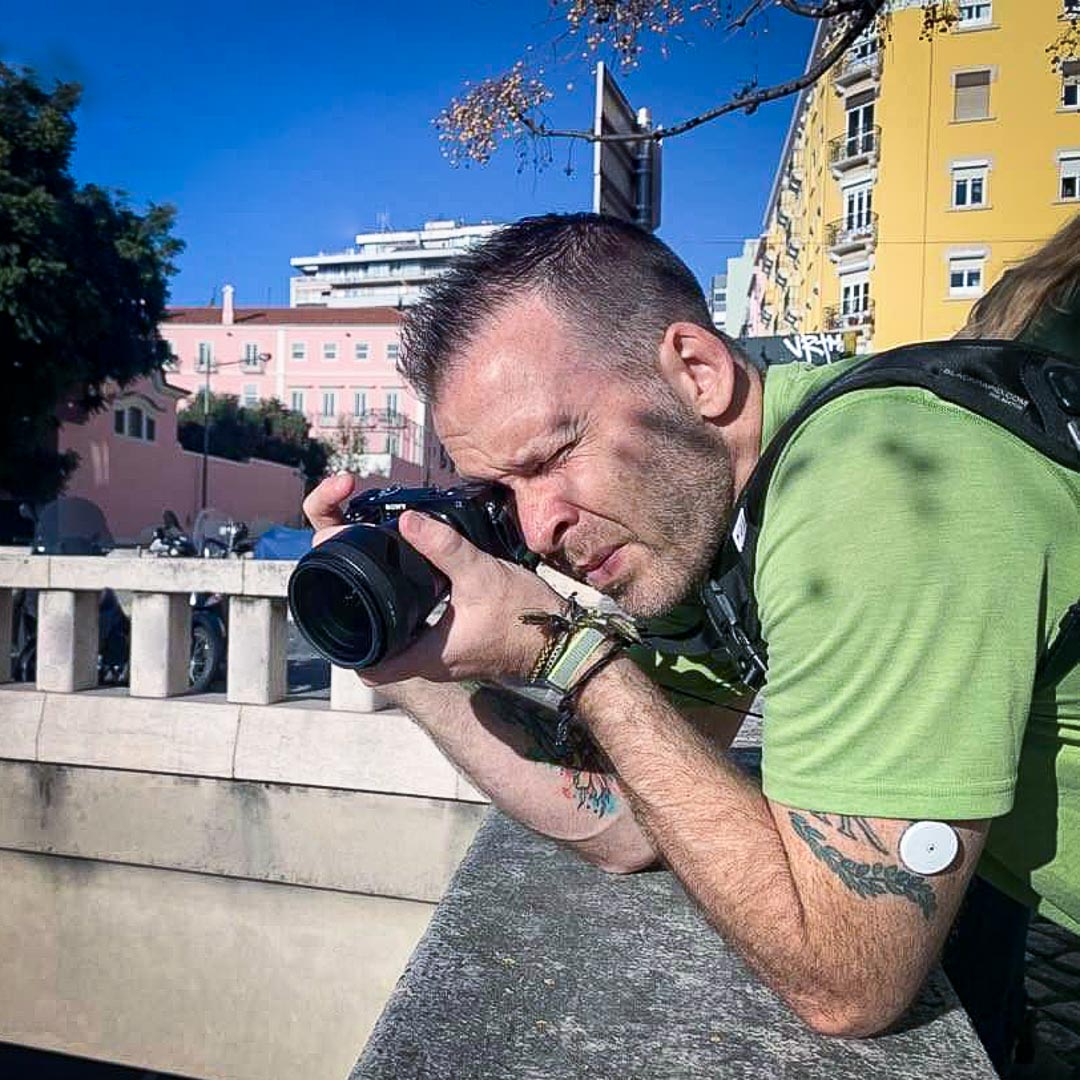

About Jason Robinson
Jason is the author of “The Beginner Traveler’s Guide To Going Nomad,” as well as the voice behind the words and the eye behind the lens for The Nomad Experiment. “Planning to travel at some point” wasn’t actually getting the job done, so nearing 40 he decided to make it a priority, nomatter how scary that was. A few years later—through the pandemic and a type 1 diabetes diagnosis at age 42—now living a life of nomadic travel, he’s speaking out to encourage others of any age, or with any serious medical diagnosis, to live an unconventional life.
Connect & Share This Article
Travel Planning Tips
Figure out where you are going & how are you getting there…
I suggest using at least 2 to 3 different travel search sites. Start with Skyscanner or Orbitz or Booking …or whatever aggregator site you prefer. Then when you see what airlines to use, check their respective sites for better deals or rewards flights.
Figure out where you’re going to stay…
If you’re interested in hostels, search Hostelworld or Hostelling International. For longer-term or more private digs, look at Airbnb, VRBO, or you can look for hotel rooms in the links from the search engines listed above.
Get comprehensive travel insurance, or in the least, travel medical insurance if internationally…
Especially with Covid not going anywhere, get covered. Start with an insurance aggregator like Insure My Trip, or with SafetyWing, World Nomads, or another. Then decide what is important to you; trip cancellation, baggage coverage, medical, or all of the above. And get a yearly evacuation plan, since you’ll have to get home after your emergency!
Need more resources? Click here!


